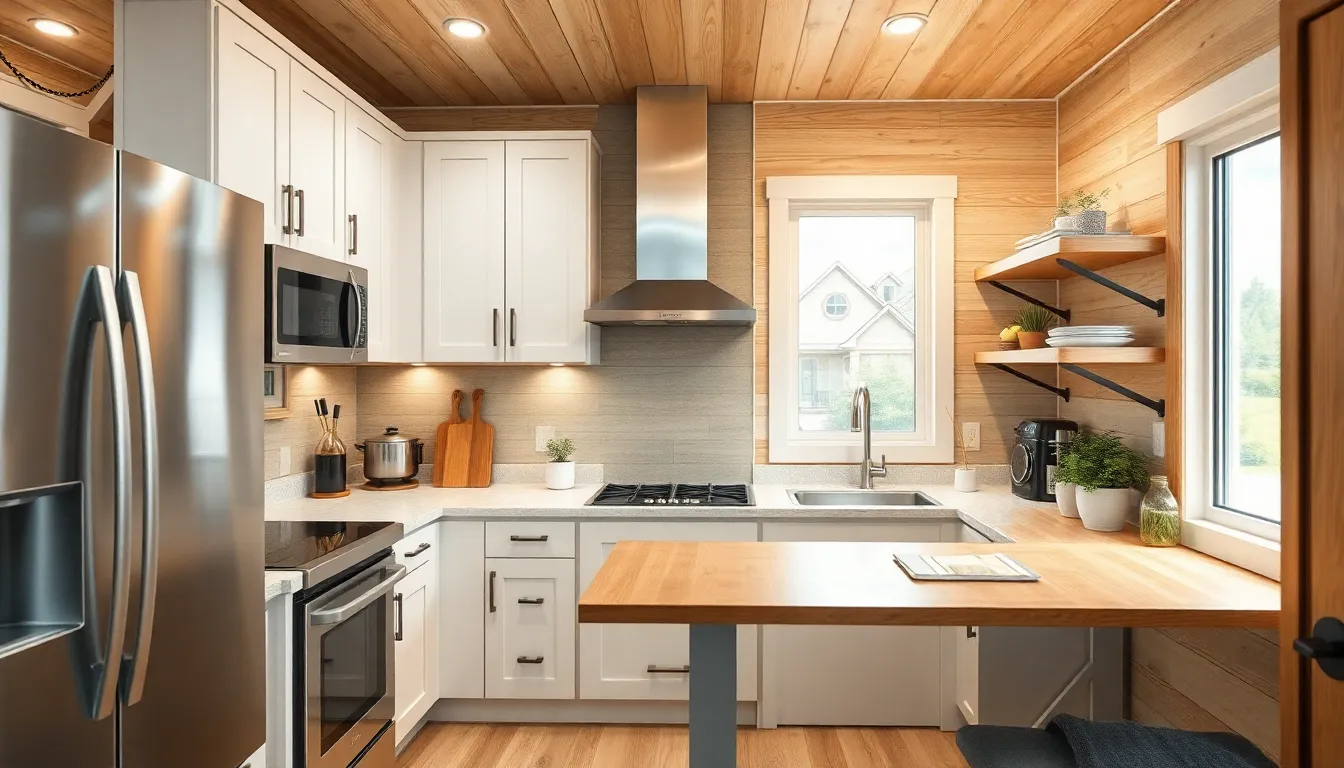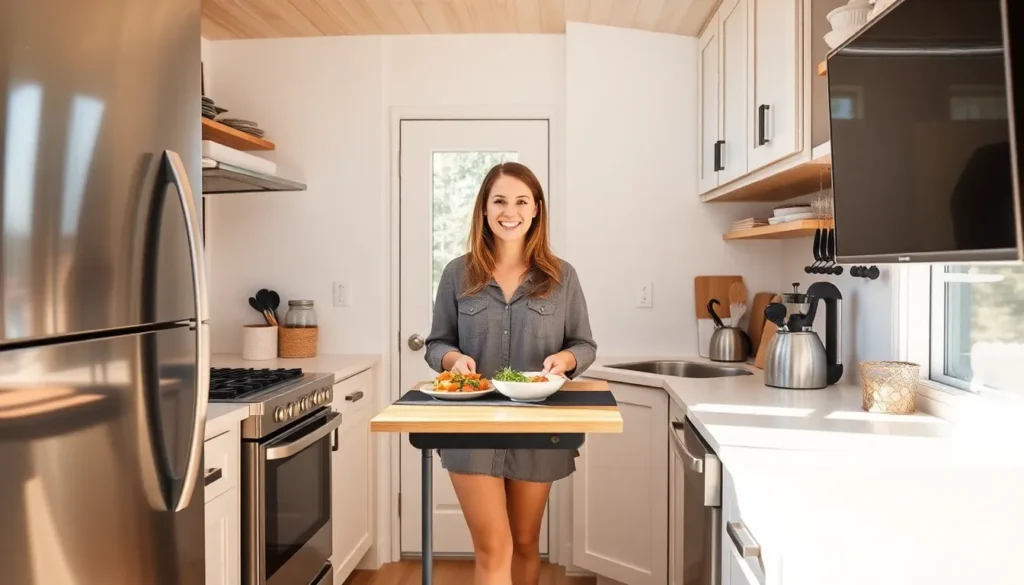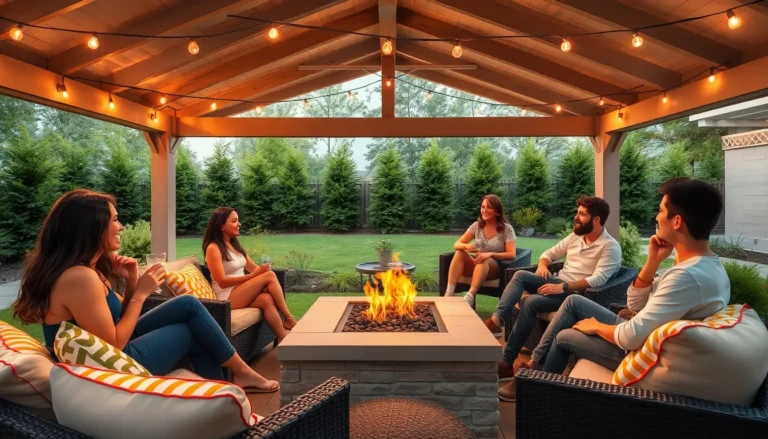Table of Contents
ToggleImagine whipping up a gourmet meal in a space smaller than your childhood bedroom. Tiny house kitchens are redefining culinary creativity, proving that good things really do come in small packages. These compact culinary havens pack a punch with smart designs and multifunctional appliances that make cooking a delightful challenge rather than a chore.
What Are Tiny House Kitchens?
Tiny house kitchens represent a unique approach to cooking and meal preparation in compact living spaces. These kitchens maximize efficiency through thoughtful design and clever use of space. Limited square footage requires owners to carefully select appliances, often opting for multifunctional units that serve more than one purpose.
Smart organization is key in tiny kitchens. Shelving, under-counter storage, and vertical space help keep essentials accessible while minimizing clutter. Creative solutions like pull-out tables or foldable countertops enhance usability and can transform the space when needed.
The layout typically prioritizes functionality. L-shaped or galley designs often appear in implementations, allowing room for movement while ensuring ease of access to all necessary cooking tools and ingredients. Key considerations include ensuring adequate ventilation and natural light, which can significantly improve the cooking environment.
Materials chosen for tiny house kitchens often reflect the overall design ethos. Sustainable options, such as reclaimed wood and recycled surfaces, commonly feature in these kitchens, aligning with the eco-conscious mindset of many tiny home dwellers. Color schemes tend to focus on lighter shades to create an illusion of more space.
Tiny house kitchens encourage culinary creativity. They inspire users to reinvent traditional cooking techniques and explore new culinary trends. This adaptability can lead to innovative meal preparations, transforming how individuals approach cooking in smaller spaces. Overall, tiny house kitchens exemplify both practicality and creativity, redefining modern cooking experiences.
Key Features of Tiny House Kitchens

Tiny house kitchens are designed to maximize efficiency and functionality within limited space. They incorporate clever, design-centric features that make cooking a practical and enjoyable experience.
Space-Saving Solutions
Smart storage options define tiny house kitchens. Cabinets that reach the ceiling provide much-needed storage without taking up valuable floor space. Choosing appliances that serve multiple purposes, like a microwave that can also bake, saves room and enhances versatility. Foldable tables and retractable countertops establish additional prep areas without permanent structures. Drawer organizers keep utensils tidy, ensuring easy access while maintaining organization. Incorporating magnetic strips for knives or spices utilizes wall space creatively.
Functional Design Elements
Design elements in tiny house kitchens emphasize practicality. L-shaped and galley layouts facilitate smooth movement, accommodating limited space efficiently. Open shelving adds accessibility for frequently used items while keeping visual clutter minimal. Stainless steel and lighter color palettes create an illusion of expansiveness, enhancing brightness and airiness. Well-placed lighting fixtures are essential, lighting specific work areas effectively without overwhelming the space. Incorporating eco-friendly materials further aligns with the sustainable ethos many tiny home dwellers cherish.
Popular Layouts for Tiny House Kitchens
Tiny house kitchens often feature efficient layouts that focus on maximizing space while ensuring functionality. Two popular designs include the galley kitchen and the L-shaped kitchen.
Galley Kitchen Layout
Galley kitchens make the most of narrow spaces by creating a streamlined cooking area. This layout typically consists of two parallel countertops with a walkway in between, allowing for easy movement between cooking and prep areas. Storage solutions often include tall cabinets and shelves on both sides, maximizing vertical space. Efficient use of this area encourages a workflow that resembles a professional kitchen. Appliances are usually placed close to each other, which enhances efficiency during meal preparation. Homeowners can also incorporate sliding doors to separate the kitchen from living areas, maintaining an open feel without sacrificing privacy.
L-Shaped Kitchen Layout
L-shaped kitchens utilize corner space to create a functional cooking zone. This design facilitates an efficient workflow, allowing for dedicated zones for cooking, prep, and chilling. Countertops extend along two adjoining walls, which increases workspace while promoting social interaction with adjacent living spaces. Storage options often include cabinets and drawers tucked into corners, optimizing otherwise unused areas. The open layout encourages natural light flow, which enhances the aesthetic appeal. Additionally, a small island can serve as a multifunctional space for dining or additional prep work. This versatile design remains popular among tiny house dwellers seeking both form and function.
Essential Appliances for Tiny House Kitchens
Tiny house kitchens rely on essential appliances that maximize functionality while saving space. These carefully selected devices elevate the cooking experience in compact environments.
Compact Refrigerators
Compact refrigerators take up minimal space while offering ample storage for fresh produce and essentials. They often come with different configurations, from top-freezer styles to side-by-side designs. These compact units typically feature energy-saving settings, which is crucial for tiny homes. High-efficiency models ensure that occupants maintain a sustainable lifestyle. Many options include built-in freezers, allowing for flexibility in food storage. Choosing a compact refrigerator that fits personal needs helps optimize space and keep snacks accessible.
Multi-Functional Cookware
Multi-functional cookware streamlines meal preparation by combining various cooking methods in a single appliance. These versatile items include pressure cookers, slow cookers, and air fryers, which cater to diverse cooking styles and recipes. The flexibility of multi-functional cookware simplifies the cooking process while conserving storage space. Storing a single pot that acts as a pressure cooker and slow cooker eliminates the need for multiple items. This versatility encourages creative meal planning, allowing tiny house dwellers to experiment with new dishes without cluttering their kitchens. Utilizing efficient cookware makes cooking easier while enhancing the overall culinary experience.
Storage Ideas for Tiny House Kitchens
Tiny house kitchens require smart storage solutions to maximize space. Creativity plays a vital role in organizing kitchen essentials efficiently.
Innovative Cabinetry
Custom cabinetry options provide tailored solutions for tiny spaces. Deep drawers offer easy access to pots, pans, and kitchen gadgets. Pull-out shelves optimize corner cabinets, making the most of otherwise wasted areas. Incorporating open shelving enhances aesthetics while providing easy visibility of frequently used items. Using lightweight materials ensures flexibility and promotes a spacious feel in compact kitchens.
Underutilized Spaces
Every nook and cranny in a tiny kitchen can serve a purpose. The area above the refrigerator often turns into a storage zone for rarely used items. Additionally, vertical space becomes crucial; wall-mounted racks allow for hanging utensils and cookware. Under-sink cabinets can benefit from stackable bins for cleaning supplies. Utilizing the underside of cabinets for hooks or magnetic strips creates extra space while maintaining accessibility.
Tiny house kitchens exemplify the art of maximizing space without sacrificing functionality. With innovative designs and smart storage solutions, these compact culinary spaces inspire creativity and efficiency. The use of multifunctional appliances and thoughtful layouts transforms cooking into an enjoyable experience.
As tiny home dwellers continue to embrace sustainable living, the focus on eco-friendly materials and energy-efficient appliances reflects a commitment to both style and responsibility. Whether opting for a galley or L-shaped layout, the versatility of tiny house kitchens showcases how limited square footage can lead to limitless culinary possibilities. Embracing these design principles not only enhances the cooking experience but also fosters a deeper connection to the art of meal preparation.




